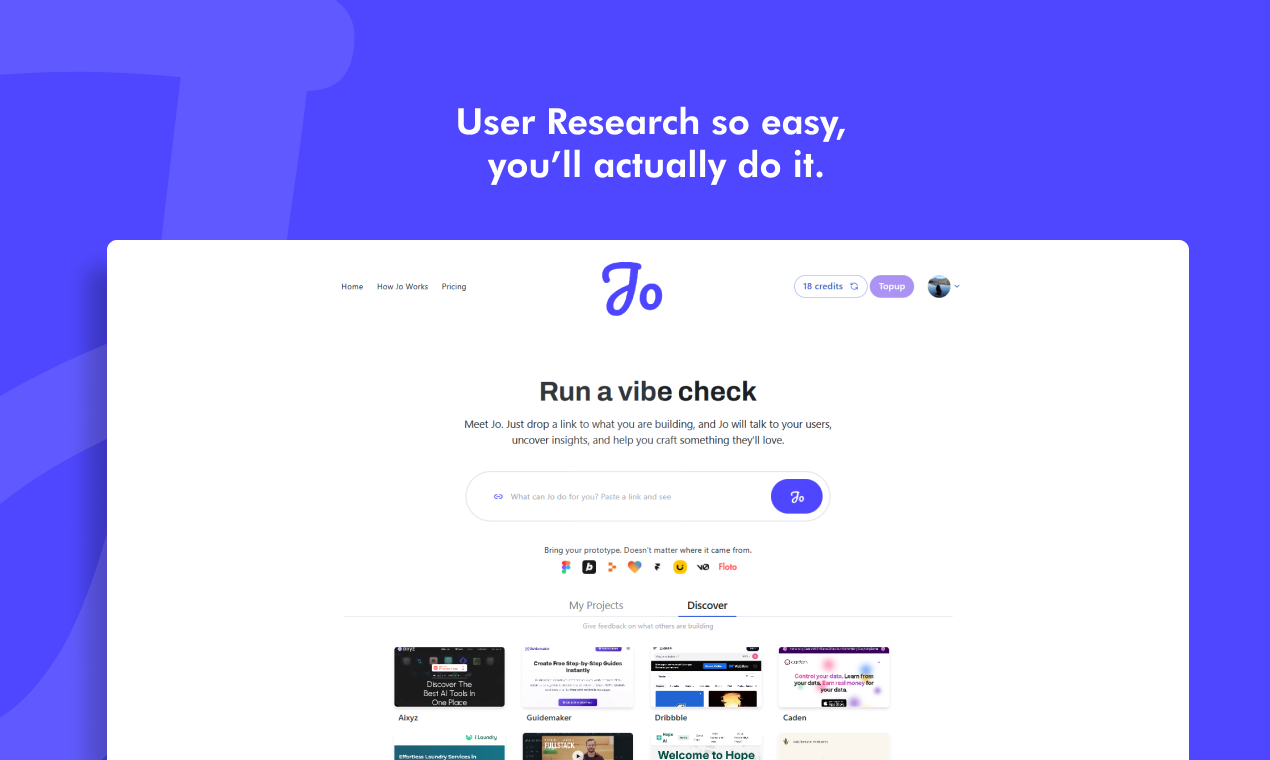
Table of Contents
Overview
In the fast-paced world of product development, getting user feedback early and often is crucial for success. But sifting through mountains of qualitative data can be a time-consuming nightmare. Enter Jo, a user research tool designed to streamline the feedback process and deliver actionable insights before you even launch. Jo empowers creators and product teams to gather structured feedback in real-time, leveraging the power of AI to synthesize qualitative input into clear, data-driven decisions. Let’s dive deeper into what makes Jo a valuable asset for product teams.
Key Features
Jo boasts a range of features designed to make user research simple and effective:
- Instant feedback via shareable link: Easily generate a unique link to share with your target audience, allowing them to provide feedback on your product or feature.
- AI-powered insight summarization: Jo uses artificial intelligence to automatically analyze and summarize user responses, extracting key themes and insights.
- Pre-launch product validation: Validate your product idea and identify potential issues before launch, saving time and resources in the long run.
- User-friendly survey creation: Create engaging and effective surveys with ease, no coding required.
- Real-time analytics dashboard: Track responses and monitor key metrics in real-time, giving you a clear picture of user sentiment.
How It Works
Using Jo is straightforward. First, you generate a feedback link through the platform, customizing the questions and survey flow to suit your specific needs. Next, you share this link with your target audience, whether it’s existing customers, potential users, or internal testers. As responses come in, Jo’s AI engine kicks in, automatically analyzing the qualitative data and synthesizing it into structured insights. Finally, you can access these insights through the real-time analytics dashboard, allowing you to quickly identify key themes and make informed decisions.
Use Cases
Jo can be applied across a variety of scenarios to improve product development and user experience:
- Testing product-market fit: Gauge user interest in your product idea before investing significant resources.
- Refining user experience pre-launch: Identify usability issues and areas for improvement before your product goes live.
- Gathering early feedback on features: Get user opinions on new features and functionalities to ensure they meet user needs.
- Informing design or pricing strategies: Use user feedback to guide design decisions and optimize your pricing model.
- Prioritizing roadmap based on user needs: Use data-driven insights to prioritize features and updates that will have the biggest impact on your users.
Pros & Cons
Like any tool, Jo has its strengths and weaknesses. Here’s a breakdown of the pros and cons:
Advantages
- Fast and simple setup: Get up and running quickly with Jo’s intuitive interface.
- Actionable AI-driven insights: Make data-driven decisions based on clear and concise summaries of user feedback.
- Great for early-stage feedback: Ideal for validating product ideas and gathering initial user insights.
Disadvantages
- Limited depth for complex studies: May not be suitable for in-depth qualitative research projects requiring advanced analysis.
- Requires audience for meaningful input: The value of Jo is dependent on having a relevant audience to provide feedback.
How Does It Compare?
When considering user research tools, it’s important to weigh your options. Jo offers a unique blend of simplicity and AI-powered insights. Compared to Maze, which offers richer UX research features but can be more complex to use, Jo provides a more streamlined experience. While Typeform offers more survey options, it lacks the AI synthesis capabilities that make Jo so efficient for extracting actionable insights.
Final Thoughts
Jo is a valuable tool for product teams looking to gather and analyze user feedback quickly and efficiently. Its AI-powered insights and user-friendly interface make it a great choice for early-stage product validation and ongoing user research. While it may not be suitable for all research needs, Jo offers a compelling solution for teams seeking to make data-driven decisions and build better products.

